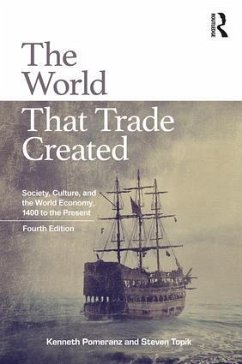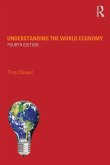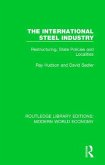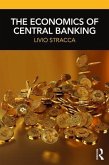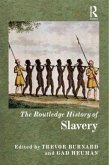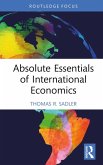Kenneth Pomeranz, Steven Topik
The World That Trade Created
Society, Culture, and the World Economy, 1400 to the Present
Kenneth Pomeranz, Steven Topik
The World That Trade Created
Society, Culture, and the World Economy, 1400 to the Present
- Broschiertes Buch
- Merkliste
- Auf die Merkliste
- Bewerten Bewerten
- Teilen
- Produkt teilen
- Produkterinnerung
- Produkterinnerung
The World That Trade Created brings to life the history of trade and its actors. In a series of brief, highly readable vignettes, filled with insights and amazing facts about things we tend to take for granted, the authors uncover the deep historical roots of economic globalization. Covering over seven hundred years of history, this book, now in its fourth edition, takes the reader around the world from the history of the opium trade to pirates, to the building of corporations and migration to the New World. The chapters are grouped thematically, each featuring an introductory essay designed…mehr
Andere Kunden interessierten sich auch für
![Understanding the World Economy Understanding the World Economy]() Tony CleaverUnderstanding the World Economy68,99 €
Tony CleaverUnderstanding the World Economy68,99 €![Atlas of the World Economy Atlas of the World Economy]() Michael Freeman (UK University of Oxford)Atlas of the World Economy55,99 €
Michael Freeman (UK University of Oxford)Atlas of the World Economy55,99 €![The Iberian World The Iberian World]() The Iberian World50,99 €
The Iberian World50,99 €![The International Steel Industry The International Steel Industry]() Ray Hudson (UK University of Durham)The International Steel Industry51,99 €
Ray Hudson (UK University of Durham)The International Steel Industry51,99 €![The Economics of Central Banking The Economics of Central Banking]() Livio StraccaThe Economics of Central Banking55,99 €
Livio StraccaThe Economics of Central Banking55,99 €![The Routledge History of Slavery The Routledge History of Slavery]() The Routledge History of Slavery59,99 €
The Routledge History of Slavery59,99 €![Absolute Essentials of International Economics Absolute Essentials of International Economics]() Thomas R. SadlerAbsolute Essentials of International Economics68,99 €
Thomas R. SadlerAbsolute Essentials of International Economics68,99 €-
-
-
The World That Trade Created brings to life the history of trade and its actors. In a series of brief, highly readable vignettes, filled with insights and amazing facts about things we tend to take for granted, the authors uncover the deep historical roots of economic globalization. Covering over seven hundred years of history, this book, now in its fourth edition, takes the reader around the world from the history of the opium trade to pirates, to the building of corporations and migration to the New World. The chapters are grouped thematically, each featuring an introductory essay designed to synthesize and elaborate on key themes, both familiar and unfamiliar. It includes ten new essays, on topics ranging from the early modern ivory and slave trades across the Indian Ocean, to the ways in which the availability of new consumer goods helped change work habits in both Europe and East Asia, and from the history of chewing gum to that of rare earth metals. The introductory essays for each chapter, the overall introduction and epilogue, and several of the essays have also been revised and updated. The World That Trade Created continues to be a key resource for anyone teaching world history, world civilization, and the history of international trade.
Hinweis: Dieser Artikel kann nur an eine deutsche Lieferadresse ausgeliefert werden.
Hinweis: Dieser Artikel kann nur an eine deutsche Lieferadresse ausgeliefert werden.
Produktdetails
- Produktdetails
- Verlag: Taylor & Francis Ltd
- 4 ed
- Seitenzahl: 360
- Erscheinungstermin: 3. Oktober 2017
- Englisch
- Abmessung: 234mm x 156mm x 19mm
- Gewicht: 536g
- ISBN-13: 9781138680746
- ISBN-10: 1138680745
- Artikelnr.: 48825222
- Herstellerkennzeichnung
- Libri GmbH
- Europaallee 1
- 36244 Bad Hersfeld
- gpsr@libri.de
- Verlag: Taylor & Francis Ltd
- 4 ed
- Seitenzahl: 360
- Erscheinungstermin: 3. Oktober 2017
- Englisch
- Abmessung: 234mm x 156mm x 19mm
- Gewicht: 536g
- ISBN-13: 9781138680746
- ISBN-10: 1138680745
- Artikelnr.: 48825222
- Herstellerkennzeichnung
- Libri GmbH
- Europaallee 1
- 36244 Bad Hersfeld
- gpsr@libri.de
Kenneth Pomeranz is University Professor in History at the University of Chicago, USA, and was President of the American Historical Association in 2013-14. Steven Topik is Professor of History at UC Irvine, USA, where he has worked since 1984. Previously he taught at Brazil's Universidade Federal Fluminense and Colgate University.
Introduction
Chapter 1 The Making of Market Conventions
1. The Fujian Trade Diaspora
2. The Chinese Tribute System
3. Funny Money, Real Growth
4. When Asia Was the World Economy
5. Treating Good News as No News
6. Pearls in the Rubble: Rediscovering the Golden Age of Quanzhou, ca.
1000-1400
7. Aztec Traders
8. Primitive Accumulation: Brazilwood
9. A British Merchant in the Tropics
10. How the Other Half Traded
11. Deals and Ordeals: World Trade and Early Modern Legal Culture
12. Traveling Salesmen, Traveling Taxmen
13. Indian Ocean Commodity Circuit: How to Turn Cotton into Ivory
14. Going Non-native: Expense Accounts and the End of the Age of Merchant
Courtiers
15. Empire on a Shoestring: British Adventurers and Indian Financiers in
Calcutta, 1750-1850
Chapter 2 Transport and Tactics
2.1 Human Ingenuity: Adapting to Natural Barriers, and Creating New Ones
2.2 Power-Driven Transport: New Time, New Space, Old Conflicts
2.3 Woods, Winds, Shipbuilding, and Shipping: Why China Didn't Rule the
Waves
2.4 Better to Be Lucky Than Smart
2.5 Seats of Government and Their Stomachs: An Eighteenth-Century Tour
2.6 Pioneers of Dusty Rooms: Warehouses, Transatlantic Trade, and the
Opening of the North American Frontier
2.7 People Patterns: Was the Real America Sichuan?
2.8 Winning Raffles
2.9 Trade, Disorder, and Progress: Creating Shanghai, 1840-1930
2.10 Out of One-Many
2.11 Guaranteed Profits and Half-Fulfilled Hopes: Railroad Building in
British India
2.12 A Brief Trip Across the Centuries
Chapter 3 The Economic Culture of Drugs
3.1 Chocolate: From Coin to Commodity
3.2 Brewing Up a Storm
3.3 Mocha Is Not Chocolate
3.4 The Brew of Business: Coffee's Life Story
3.5 America and the Coffee Bean
3.6 Sweet Revolutions
3.7 Paying for Power: "Sin Taxes" and the Rise of the Modern State
3.8 How Opium Made the World Go 'Round
3.9 Tobacco: the Rise and Decline of a Magical Weed
3.10 Making Smoking Modern: From Pipes to Cigarettes in Egypt and Elsewhere
3.11 Chewing Is Good, Snorting Isn't: How Chemistry Turned a Good Thing Bad
Chapter 4 Transplanting
4.1 Unnatural Resources
4.2 Bouncing Around
4.3 Golden Misfortune: John Sutter in the Wilds of California
4.4 California Gold and the World
4.5 El Dorado or Wild Coast? How a Remote Place was washed by the Tides of
World History
4.6 Beautiful Bugs
4.7 How to Turn Nothing into Something: Guano's Ephemeral Fortunes
4.8 As American as Sugar and Pineapples
4.9 How the Cows Ate the Cowboys
4.10 The Tie That Bound
4.11 The Good Earth?
4.12 One Potato, Two Potato
4.13 Cocoa and Coercion: Advances and Retreats for Free Labor in West
African Agriculture
4.14 Trying to Get a Grip: Natural Rubber's Century of Ups and Downs
Chapter 5 The Economics of Violence
5.1 The Logic of an Immoral Trade
5.2 As Rich as Potosí
5.3 The Freebooting Founders of England's Free Seas
5.4 Adventure, Trade, Piracy: Anthony Shirley and Pedro Teixeira, Two Early
Modern Travelers
5.5 The Luxurious Life of Robinson Crusoe
5.6 No Islands in the Storm: Or, How the Sino-British Tea Trade Deluged the
Worlds of Pacific Islanders
5.7 The Violent Birth of Corporations
5.8 Buccaneers as Corporate Raiders
5.9 Looking for the Next Worst Thing: Emancipation, Indentures, and
Colonial Plantations After Slavery
5.10 Bloody Ivory Tower
5.11 How Africa Resisted Imperialism: Ethiopia and the World Economy
5.12 Never Again: The Saga of the Rosenfelders
Chapter 6 Making Modern Markets
6.1 Silver and Gold in Mexico and Brazil
6.2 Weighing the World: The Metric Revolution
6.3 From Court Bankers to Architects of the Modern World Market: The
Rothschilds
6.4 Growing Global: International Grain Markets
6.5 How Time Got That Way
6.6 How the United States Joined the Big Leagues
6.7 Clubs, Casinos, and Collapses: Sovereign Debt and Risk Management Since
1820
6.8 Fresher Is Not Better
6.9 Packaging
6.10 Trademarks: What's in a Name?
6.11 Learning to Feel Unclean: A Global Marketing Tale
6.12 Chewing on global History: Wrigley, Adams, and the Yucatan
6.13 Things Go Better with Red, White, and Blue: How Coca-Cola Conquered
Europe
6.14 Survival of the First
6.15 It Ain't Necessarily So
6.16 Location, Location, Location: How History Trumped Geography in Andorra
and Panama
Chapter 7 World Trade, Industrialization, and Deindustrialization
7.1 Sweet Industry: The First Factories
7.2 Why We Work So Hard: The Industrious Revolution and the Early Modern
World
7.3 Fiber of Fortune: How Cotton Became the Fabric of the Industrial Age
7.4 Combing the World for Cotton
7.5 Killing the Golden Goose
7.6 Sweet Success
7.7 No Mill Is an Island
7.8 Feeding Silkworms, Spitting Out Growth
7.9 From Rocks-and Restrictions-to Riches: How Disadvantages Helped New
England Industrialize Early
7.10 Sideways Breakthroughs and Stalled Transitions: Crooked Paths from
Coal to Oil, 1859-2012
7.11 American Oil
7.12 Running on Oil, Building on Sand
7.13 Not So Rare, But Pretty Strange: How Rare Earth Metals Became a
Chinese "Monopoly"
7.14 Minding the Store and Forgetting the Factory: U.S. "Fair Trade" Laws
and the Rise of Offshore Manufacturing Since World War II
Epilogue: The World Economy in the Twenty-First Century
Chapter 1 The Making of Market Conventions
1. The Fujian Trade Diaspora
2. The Chinese Tribute System
3. Funny Money, Real Growth
4. When Asia Was the World Economy
5. Treating Good News as No News
6. Pearls in the Rubble: Rediscovering the Golden Age of Quanzhou, ca.
1000-1400
7. Aztec Traders
8. Primitive Accumulation: Brazilwood
9. A British Merchant in the Tropics
10. How the Other Half Traded
11. Deals and Ordeals: World Trade and Early Modern Legal Culture
12. Traveling Salesmen, Traveling Taxmen
13. Indian Ocean Commodity Circuit: How to Turn Cotton into Ivory
14. Going Non-native: Expense Accounts and the End of the Age of Merchant
Courtiers
15. Empire on a Shoestring: British Adventurers and Indian Financiers in
Calcutta, 1750-1850
Chapter 2 Transport and Tactics
2.1 Human Ingenuity: Adapting to Natural Barriers, and Creating New Ones
2.2 Power-Driven Transport: New Time, New Space, Old Conflicts
2.3 Woods, Winds, Shipbuilding, and Shipping: Why China Didn't Rule the
Waves
2.4 Better to Be Lucky Than Smart
2.5 Seats of Government and Their Stomachs: An Eighteenth-Century Tour
2.6 Pioneers of Dusty Rooms: Warehouses, Transatlantic Trade, and the
Opening of the North American Frontier
2.7 People Patterns: Was the Real America Sichuan?
2.8 Winning Raffles
2.9 Trade, Disorder, and Progress: Creating Shanghai, 1840-1930
2.10 Out of One-Many
2.11 Guaranteed Profits and Half-Fulfilled Hopes: Railroad Building in
British India
2.12 A Brief Trip Across the Centuries
Chapter 3 The Economic Culture of Drugs
3.1 Chocolate: From Coin to Commodity
3.2 Brewing Up a Storm
3.3 Mocha Is Not Chocolate
3.4 The Brew of Business: Coffee's Life Story
3.5 America and the Coffee Bean
3.6 Sweet Revolutions
3.7 Paying for Power: "Sin Taxes" and the Rise of the Modern State
3.8 How Opium Made the World Go 'Round
3.9 Tobacco: the Rise and Decline of a Magical Weed
3.10 Making Smoking Modern: From Pipes to Cigarettes in Egypt and Elsewhere
3.11 Chewing Is Good, Snorting Isn't: How Chemistry Turned a Good Thing Bad
Chapter 4 Transplanting
4.1 Unnatural Resources
4.2 Bouncing Around
4.3 Golden Misfortune: John Sutter in the Wilds of California
4.4 California Gold and the World
4.5 El Dorado or Wild Coast? How a Remote Place was washed by the Tides of
World History
4.6 Beautiful Bugs
4.7 How to Turn Nothing into Something: Guano's Ephemeral Fortunes
4.8 As American as Sugar and Pineapples
4.9 How the Cows Ate the Cowboys
4.10 The Tie That Bound
4.11 The Good Earth?
4.12 One Potato, Two Potato
4.13 Cocoa and Coercion: Advances and Retreats for Free Labor in West
African Agriculture
4.14 Trying to Get a Grip: Natural Rubber's Century of Ups and Downs
Chapter 5 The Economics of Violence
5.1 The Logic of an Immoral Trade
5.2 As Rich as Potosí
5.3 The Freebooting Founders of England's Free Seas
5.4 Adventure, Trade, Piracy: Anthony Shirley and Pedro Teixeira, Two Early
Modern Travelers
5.5 The Luxurious Life of Robinson Crusoe
5.6 No Islands in the Storm: Or, How the Sino-British Tea Trade Deluged the
Worlds of Pacific Islanders
5.7 The Violent Birth of Corporations
5.8 Buccaneers as Corporate Raiders
5.9 Looking for the Next Worst Thing: Emancipation, Indentures, and
Colonial Plantations After Slavery
5.10 Bloody Ivory Tower
5.11 How Africa Resisted Imperialism: Ethiopia and the World Economy
5.12 Never Again: The Saga of the Rosenfelders
Chapter 6 Making Modern Markets
6.1 Silver and Gold in Mexico and Brazil
6.2 Weighing the World: The Metric Revolution
6.3 From Court Bankers to Architects of the Modern World Market: The
Rothschilds
6.4 Growing Global: International Grain Markets
6.5 How Time Got That Way
6.6 How the United States Joined the Big Leagues
6.7 Clubs, Casinos, and Collapses: Sovereign Debt and Risk Management Since
1820
6.8 Fresher Is Not Better
6.9 Packaging
6.10 Trademarks: What's in a Name?
6.11 Learning to Feel Unclean: A Global Marketing Tale
6.12 Chewing on global History: Wrigley, Adams, and the Yucatan
6.13 Things Go Better with Red, White, and Blue: How Coca-Cola Conquered
Europe
6.14 Survival of the First
6.15 It Ain't Necessarily So
6.16 Location, Location, Location: How History Trumped Geography in Andorra
and Panama
Chapter 7 World Trade, Industrialization, and Deindustrialization
7.1 Sweet Industry: The First Factories
7.2 Why We Work So Hard: The Industrious Revolution and the Early Modern
World
7.3 Fiber of Fortune: How Cotton Became the Fabric of the Industrial Age
7.4 Combing the World for Cotton
7.5 Killing the Golden Goose
7.6 Sweet Success
7.7 No Mill Is an Island
7.8 Feeding Silkworms, Spitting Out Growth
7.9 From Rocks-and Restrictions-to Riches: How Disadvantages Helped New
England Industrialize Early
7.10 Sideways Breakthroughs and Stalled Transitions: Crooked Paths from
Coal to Oil, 1859-2012
7.11 American Oil
7.12 Running on Oil, Building on Sand
7.13 Not So Rare, But Pretty Strange: How Rare Earth Metals Became a
Chinese "Monopoly"
7.14 Minding the Store and Forgetting the Factory: U.S. "Fair Trade" Laws
and the Rise of Offshore Manufacturing Since World War II
Epilogue: The World Economy in the Twenty-First Century
Introduction
Chapter 1 The Making of Market Conventions
1. The Fujian Trade Diaspora
2. The Chinese Tribute System
3. Funny Money, Real Growth
4. When Asia Was the World Economy
5. Treating Good News as No News
6. Pearls in the Rubble: Rediscovering the Golden Age of Quanzhou, ca.
1000-1400
7. Aztec Traders
8. Primitive Accumulation: Brazilwood
9. A British Merchant in the Tropics
10. How the Other Half Traded
11. Deals and Ordeals: World Trade and Early Modern Legal Culture
12. Traveling Salesmen, Traveling Taxmen
13. Indian Ocean Commodity Circuit: How to Turn Cotton into Ivory
14. Going Non-native: Expense Accounts and the End of the Age of Merchant
Courtiers
15. Empire on a Shoestring: British Adventurers and Indian Financiers in
Calcutta, 1750-1850
Chapter 2 Transport and Tactics
2.1 Human Ingenuity: Adapting to Natural Barriers, and Creating New Ones
2.2 Power-Driven Transport: New Time, New Space, Old Conflicts
2.3 Woods, Winds, Shipbuilding, and Shipping: Why China Didn't Rule the
Waves
2.4 Better to Be Lucky Than Smart
2.5 Seats of Government and Their Stomachs: An Eighteenth-Century Tour
2.6 Pioneers of Dusty Rooms: Warehouses, Transatlantic Trade, and the
Opening of the North American Frontier
2.7 People Patterns: Was the Real America Sichuan?
2.8 Winning Raffles
2.9 Trade, Disorder, and Progress: Creating Shanghai, 1840-1930
2.10 Out of One-Many
2.11 Guaranteed Profits and Half-Fulfilled Hopes: Railroad Building in
British India
2.12 A Brief Trip Across the Centuries
Chapter 3 The Economic Culture of Drugs
3.1 Chocolate: From Coin to Commodity
3.2 Brewing Up a Storm
3.3 Mocha Is Not Chocolate
3.4 The Brew of Business: Coffee's Life Story
3.5 America and the Coffee Bean
3.6 Sweet Revolutions
3.7 Paying for Power: "Sin Taxes" and the Rise of the Modern State
3.8 How Opium Made the World Go 'Round
3.9 Tobacco: the Rise and Decline of a Magical Weed
3.10 Making Smoking Modern: From Pipes to Cigarettes in Egypt and Elsewhere
3.11 Chewing Is Good, Snorting Isn't: How Chemistry Turned a Good Thing Bad
Chapter 4 Transplanting
4.1 Unnatural Resources
4.2 Bouncing Around
4.3 Golden Misfortune: John Sutter in the Wilds of California
4.4 California Gold and the World
4.5 El Dorado or Wild Coast? How a Remote Place was washed by the Tides of
World History
4.6 Beautiful Bugs
4.7 How to Turn Nothing into Something: Guano's Ephemeral Fortunes
4.8 As American as Sugar and Pineapples
4.9 How the Cows Ate the Cowboys
4.10 The Tie That Bound
4.11 The Good Earth?
4.12 One Potato, Two Potato
4.13 Cocoa and Coercion: Advances and Retreats for Free Labor in West
African Agriculture
4.14 Trying to Get a Grip: Natural Rubber's Century of Ups and Downs
Chapter 5 The Economics of Violence
5.1 The Logic of an Immoral Trade
5.2 As Rich as Potosí
5.3 The Freebooting Founders of England's Free Seas
5.4 Adventure, Trade, Piracy: Anthony Shirley and Pedro Teixeira, Two Early
Modern Travelers
5.5 The Luxurious Life of Robinson Crusoe
5.6 No Islands in the Storm: Or, How the Sino-British Tea Trade Deluged the
Worlds of Pacific Islanders
5.7 The Violent Birth of Corporations
5.8 Buccaneers as Corporate Raiders
5.9 Looking for the Next Worst Thing: Emancipation, Indentures, and
Colonial Plantations After Slavery
5.10 Bloody Ivory Tower
5.11 How Africa Resisted Imperialism: Ethiopia and the World Economy
5.12 Never Again: The Saga of the Rosenfelders
Chapter 6 Making Modern Markets
6.1 Silver and Gold in Mexico and Brazil
6.2 Weighing the World: The Metric Revolution
6.3 From Court Bankers to Architects of the Modern World Market: The
Rothschilds
6.4 Growing Global: International Grain Markets
6.5 How Time Got That Way
6.6 How the United States Joined the Big Leagues
6.7 Clubs, Casinos, and Collapses: Sovereign Debt and Risk Management Since
1820
6.8 Fresher Is Not Better
6.9 Packaging
6.10 Trademarks: What's in a Name?
6.11 Learning to Feel Unclean: A Global Marketing Tale
6.12 Chewing on global History: Wrigley, Adams, and the Yucatan
6.13 Things Go Better with Red, White, and Blue: How Coca-Cola Conquered
Europe
6.14 Survival of the First
6.15 It Ain't Necessarily So
6.16 Location, Location, Location: How History Trumped Geography in Andorra
and Panama
Chapter 7 World Trade, Industrialization, and Deindustrialization
7.1 Sweet Industry: The First Factories
7.2 Why We Work So Hard: The Industrious Revolution and the Early Modern
World
7.3 Fiber of Fortune: How Cotton Became the Fabric of the Industrial Age
7.4 Combing the World for Cotton
7.5 Killing the Golden Goose
7.6 Sweet Success
7.7 No Mill Is an Island
7.8 Feeding Silkworms, Spitting Out Growth
7.9 From Rocks-and Restrictions-to Riches: How Disadvantages Helped New
England Industrialize Early
7.10 Sideways Breakthroughs and Stalled Transitions: Crooked Paths from
Coal to Oil, 1859-2012
7.11 American Oil
7.12 Running on Oil, Building on Sand
7.13 Not So Rare, But Pretty Strange: How Rare Earth Metals Became a
Chinese "Monopoly"
7.14 Minding the Store and Forgetting the Factory: U.S. "Fair Trade" Laws
and the Rise of Offshore Manufacturing Since World War II
Epilogue: The World Economy in the Twenty-First Century
Chapter 1 The Making of Market Conventions
1. The Fujian Trade Diaspora
2. The Chinese Tribute System
3. Funny Money, Real Growth
4. When Asia Was the World Economy
5. Treating Good News as No News
6. Pearls in the Rubble: Rediscovering the Golden Age of Quanzhou, ca.
1000-1400
7. Aztec Traders
8. Primitive Accumulation: Brazilwood
9. A British Merchant in the Tropics
10. How the Other Half Traded
11. Deals and Ordeals: World Trade and Early Modern Legal Culture
12. Traveling Salesmen, Traveling Taxmen
13. Indian Ocean Commodity Circuit: How to Turn Cotton into Ivory
14. Going Non-native: Expense Accounts and the End of the Age of Merchant
Courtiers
15. Empire on a Shoestring: British Adventurers and Indian Financiers in
Calcutta, 1750-1850
Chapter 2 Transport and Tactics
2.1 Human Ingenuity: Adapting to Natural Barriers, and Creating New Ones
2.2 Power-Driven Transport: New Time, New Space, Old Conflicts
2.3 Woods, Winds, Shipbuilding, and Shipping: Why China Didn't Rule the
Waves
2.4 Better to Be Lucky Than Smart
2.5 Seats of Government and Their Stomachs: An Eighteenth-Century Tour
2.6 Pioneers of Dusty Rooms: Warehouses, Transatlantic Trade, and the
Opening of the North American Frontier
2.7 People Patterns: Was the Real America Sichuan?
2.8 Winning Raffles
2.9 Trade, Disorder, and Progress: Creating Shanghai, 1840-1930
2.10 Out of One-Many
2.11 Guaranteed Profits and Half-Fulfilled Hopes: Railroad Building in
British India
2.12 A Brief Trip Across the Centuries
Chapter 3 The Economic Culture of Drugs
3.1 Chocolate: From Coin to Commodity
3.2 Brewing Up a Storm
3.3 Mocha Is Not Chocolate
3.4 The Brew of Business: Coffee's Life Story
3.5 America and the Coffee Bean
3.6 Sweet Revolutions
3.7 Paying for Power: "Sin Taxes" and the Rise of the Modern State
3.8 How Opium Made the World Go 'Round
3.9 Tobacco: the Rise and Decline of a Magical Weed
3.10 Making Smoking Modern: From Pipes to Cigarettes in Egypt and Elsewhere
3.11 Chewing Is Good, Snorting Isn't: How Chemistry Turned a Good Thing Bad
Chapter 4 Transplanting
4.1 Unnatural Resources
4.2 Bouncing Around
4.3 Golden Misfortune: John Sutter in the Wilds of California
4.4 California Gold and the World
4.5 El Dorado or Wild Coast? How a Remote Place was washed by the Tides of
World History
4.6 Beautiful Bugs
4.7 How to Turn Nothing into Something: Guano's Ephemeral Fortunes
4.8 As American as Sugar and Pineapples
4.9 How the Cows Ate the Cowboys
4.10 The Tie That Bound
4.11 The Good Earth?
4.12 One Potato, Two Potato
4.13 Cocoa and Coercion: Advances and Retreats for Free Labor in West
African Agriculture
4.14 Trying to Get a Grip: Natural Rubber's Century of Ups and Downs
Chapter 5 The Economics of Violence
5.1 The Logic of an Immoral Trade
5.2 As Rich as Potosí
5.3 The Freebooting Founders of England's Free Seas
5.4 Adventure, Trade, Piracy: Anthony Shirley and Pedro Teixeira, Two Early
Modern Travelers
5.5 The Luxurious Life of Robinson Crusoe
5.6 No Islands in the Storm: Or, How the Sino-British Tea Trade Deluged the
Worlds of Pacific Islanders
5.7 The Violent Birth of Corporations
5.8 Buccaneers as Corporate Raiders
5.9 Looking for the Next Worst Thing: Emancipation, Indentures, and
Colonial Plantations After Slavery
5.10 Bloody Ivory Tower
5.11 How Africa Resisted Imperialism: Ethiopia and the World Economy
5.12 Never Again: The Saga of the Rosenfelders
Chapter 6 Making Modern Markets
6.1 Silver and Gold in Mexico and Brazil
6.2 Weighing the World: The Metric Revolution
6.3 From Court Bankers to Architects of the Modern World Market: The
Rothschilds
6.4 Growing Global: International Grain Markets
6.5 How Time Got That Way
6.6 How the United States Joined the Big Leagues
6.7 Clubs, Casinos, and Collapses: Sovereign Debt and Risk Management Since
1820
6.8 Fresher Is Not Better
6.9 Packaging
6.10 Trademarks: What's in a Name?
6.11 Learning to Feel Unclean: A Global Marketing Tale
6.12 Chewing on global History: Wrigley, Adams, and the Yucatan
6.13 Things Go Better with Red, White, and Blue: How Coca-Cola Conquered
Europe
6.14 Survival of the First
6.15 It Ain't Necessarily So
6.16 Location, Location, Location: How History Trumped Geography in Andorra
and Panama
Chapter 7 World Trade, Industrialization, and Deindustrialization
7.1 Sweet Industry: The First Factories
7.2 Why We Work So Hard: The Industrious Revolution and the Early Modern
World
7.3 Fiber of Fortune: How Cotton Became the Fabric of the Industrial Age
7.4 Combing the World for Cotton
7.5 Killing the Golden Goose
7.6 Sweet Success
7.7 No Mill Is an Island
7.8 Feeding Silkworms, Spitting Out Growth
7.9 From Rocks-and Restrictions-to Riches: How Disadvantages Helped New
England Industrialize Early
7.10 Sideways Breakthroughs and Stalled Transitions: Crooked Paths from
Coal to Oil, 1859-2012
7.11 American Oil
7.12 Running on Oil, Building on Sand
7.13 Not So Rare, But Pretty Strange: How Rare Earth Metals Became a
Chinese "Monopoly"
7.14 Minding the Store and Forgetting the Factory: U.S. "Fair Trade" Laws
and the Rise of Offshore Manufacturing Since World War II
Epilogue: The World Economy in the Twenty-First Century

